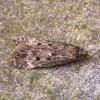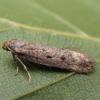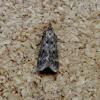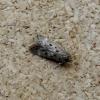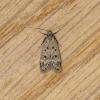35.043 Bryotropha galbanella (Zeller, 1839)
Status and Distribution
Very local, formerly found in reasonable numbers at regularly visited sites in the 19th century. More recently only reported in small numbers but does not appear to be demonstrating any contraction of range.
Predominantly a Scottish moth with its centre of population in the Highlands. Elsewhere in Scotland, there are scattered records, mainly from coastal dune systems and an isolated hill in the North East and three lowland raised bogs (mosses) in the central and southern lowlands. In England it occurs at Malham Tarn (1958 - 2011), Yorkshire and, in 2014, a single male was attracted to MV light in Buttermere, Cumbria. It appears to be absent from Wales, all of Ireland, Northern Ireland and the far north of Scotland, including the Western and Northern Isles.

Provisional map
Foodplant and Larval Feeding Signs
Dicranum scoparium (broom fork-moss), see distribution map.
In a silken tube.
Habitat
Most Scottish records are associated with areas of scots pine forest but there are also records from three well separated coastal duneland sites, a few lower level raised bogs (mossland), and an upland limestone site in Yorkshire. In North East Scotland it has been found, as an adult, resting in heather overhanging a bare peat face on a flat-topped, peaty, heather-clad hill several hundred metres away from woodland and surrounded by agricultural land.
A larva was found in moss below a large Pinus sylvestris (caledonian pine).
Finding the Moth
Larva: in an opaque whitish silken tube within the moss, open at both ends and covered with moss fragments; upper end with long silk strands attached to surrounding vegetation.
Adult: can be disturbed during the day and does occasionally come to light.
Similar Species
Well marked specimens may superficially resemble a small Scopariinae on first glance due to the shape of the forewings and contrasting light and dark markings. Indications of melanism are found in Scotland and dark forms of the males can be confused with B. boreella (whose females of which have narrower, slightly tapering wings) which is usually smaller and darker lacking the ochreous scales of the forewing. In this instance, B. galbanella has the inside of the labial palps pale yellow, whereas they are pale grey in B. boreella. Both the male and female genitalia are similar to B. boreella.
Single brooded during July and August.
Earliest: 25th June 1998 (VC92)
Latest: 22nd August 1986 (VC87)

